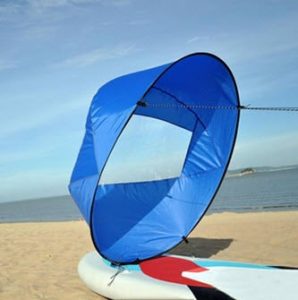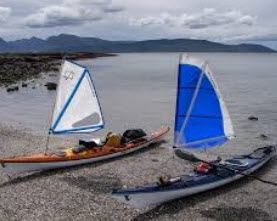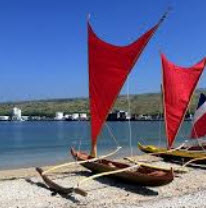Kayak Sailing Tips and Tricks FAQ
 If you have ever considered an activity that will make kayaking more fun, now would be the right time to try one – kayak sailing. In these past couple of years there has been a rapid rise in kayak sailing. From new sails, to kayaks that are made to accommodate sails from the get go, it’s now easier than ever to get into kayak sailing. And if you don’t want to get a new kayak just for that, chances are you can easily adjust your own for sailing. Either buy a kayak sailing kit, or just make one yourself – that’s actually surprisingly simple.
If you have ever considered an activity that will make kayaking more fun, now would be the right time to try one – kayak sailing. In these past couple of years there has been a rapid rise in kayak sailing. From new sails, to kayaks that are made to accommodate sails from the get go, it’s now easier than ever to get into kayak sailing. And if you don’t want to get a new kayak just for that, chances are you can easily adjust your own for sailing. Either buy a kayak sailing kit, or just make one yourself – that’s actually surprisingly simple.
Looking for a kayak Sail? Check out our comprehensive guide below.Kayak Sails Guide.
Getting back to the original point, kayak sailing is a very fun sport, and it comes with a couple of notable advantages over paddling. To begin with, you’ll get much less tired. Your main movement is propelled by the wind instead of your hands, making things much easier. If you’re kayak fishing, or out on longer sessions on the water, this can come in very handy. You also have your hands free, and you can easily do things such as wildlife photography while still moving. When you’re paddling, it’s a bit difficult to do something else since your hands are occupied.
Whether you’re just getting into kayak paddling, or have been doing it for some time already, nobody is perfect at it. There’s always room for improvement. That improvement often comes from yourself, so below we’ll give you a few tips you can try next time you are out kayak sailing. They’ll improve on your general kayak sailing skills, and will make things extremely simple in a few other ways as well. Without wasting any more time, let’s get into it.
 Oh – just one more thing. Before we even get into the tips, we must note that there are absolutely no rules to be followed here. Kayaking, whether it’s paddling or kayak sailing, is an activity that’s all about having fun, enjoying the water and the wind. You don’t have to follow what we say above, especially when doing things in another way is more fun for you. Just putting it out there.
Oh – just one more thing. Before we even get into the tips, we must note that there are absolutely no rules to be followed here. Kayaking, whether it’s paddling or kayak sailing, is an activity that’s all about having fun, enjoying the water and the wind. You don’t have to follow what we say above, especially when doing things in another way is more fun for you. Just putting it out there.
- Know when to pick up the paddle again. A kayak, or any other object for that matter, requires more energy to accelerate than it does to keep moving and maintain speed. If you’ve ever wondered, this is why a car uses up more fuel when you’re driving in the city, than on the highway. If you want to conserve a bit of energy, it makes more sense to keep the boat moving. When you notice that the wind that was propelling you a few seconds ago isn’t blowing anymore, grab the paddle and start paddling before you lose momentum.
- Use your paddle to build momentum in the first place. Even though it’s less tiring for you to let the wind do the heavy lifting, it’s no secret that you’ll be much better at picking up speed. You can invest more strength and power in accelerating. Sure, you could let the wind do this, and it would work. But it will be much slower, and you’ll eventually get annoyed by all the waiting and do it yourself. If you want to save yourself some time, just do it yourself from the start.
- The best speed for sailing upwind is less than 15 knots, while the best speed for windward sailing is probably between 10 and 12 knots. There are two main reasons for this. The first one is that our body creates friction, and so does the boat, as well as the rig in the wind. This severely slows upwind progress. The second one is that waves will slow down your boat and kill momentum. Even though you could get a slimmer design kayak sail, and reduce its frictional profile in the wind, there’s not much you can do about your body size. Well, maybe consider a diet, but there are more efficient and simpler solutions. To put it simply, when you’re holding an upwind course, you’re actually fighting both the wind and the sea at the same time.
- Instead of bracing with your paddle, lean your torso out to windward in order to compensate for heeling. In regular situations, if you want to prevent the boat from capsizing, you would brace with your paddle, and push it against the surface of the water. And yes, this would help for downwind sailing, provided your kayak isn’t leaning over. But on a beam, or close reach, when you have side wind pushing your boat sideways, that same technique doesn’t work too well. In this case, the position of your torso is important, and you should use it as a counterbalance to offset the sail’s heeling forces. Leaning your torso to windward is how you want to go about preventing capsizing. However, one more thing to note is that at some point, your torso might not be sufficient to prevent heeling. At that point, you want to ease the mainsheet in order to spill some power from the sail. Your torso will be a more productive counterbalance like that.
- Practice your low angle paddle stroke. When you’re paddling, lifting your paddle high up isn’t an issue. However, if you have a sail, that might lead to you hitting the back edge of the main sail with the blade that’s out of the water. The key here is to paddle at a lower angle, or buy a low angle paddle. A low angle paddle often has a longer shaft and narrower blades, making them easier to fit during the power stroke.
Everything we spoke about so far has more or less to do with your paddling technique, as well as your positions in or on the kayak. But what about everything else? What about the equipment, and the area you’ll be sailing in? Those are also important things, so let’s touch upon some of them as well, with some more beginner-friendly tips.
 The first and most important thing is to know the area you’re going to be sailing in, and your equipment. You must know very well where you’re going, and things that you need to keep an eye out for. It’s crucial, especially when you’re going in an area that’s somewhat new for you. Also, try to be aware of the woods surrounding you, and not just the water.
The first and most important thing is to know the area you’re going to be sailing in, and your equipment. You must know very well where you’re going, and things that you need to keep an eye out for. It’s crucial, especially when you’re going in an area that’s somewhat new for you. Also, try to be aware of the woods surrounding you, and not just the water.
This will help you with avoiding swimmers, as well as any potential hazards such as dangerous animals. You also might want to check the forecast where you’re going. This is very important, because getting caught out in the rain when you’re far from shore can completely ruin your experience. And not just that, everything you have that isn’t in a watertight box is bound to get wet, and you could even get stuck with thunderstorms or something similar.
As far as your equipment is concerned, you should know it well. The kayak, the paddle, the sail, they’re all things that require mastering. For example, your sail might require a special way of operation – you can’t be learning that when you’re miles from the nearest shore, that’s a recipe for disaster. Before you go out in the water, make sure that you’re well aware of what your kayak and gear can and can’t handle, and how you’d go about operating them, both on the shore and off it. It’s not just knowing it, though.
 You should make sure you maintain it well. Once you’re done with your session out in the water, clean your kayak. You could give your sail a wipe, too. Depending on what material it’s made of, dirt can easily damage your kayak, which isn’t something you want. And you get the bonus of looking good out on the water, too.
You should make sure you maintain it well. Once you’re done with your session out in the water, clean your kayak. You could give your sail a wipe, too. Depending on what material it’s made of, dirt can easily damage your kayak, which isn’t something you want. And you get the bonus of looking good out on the water, too.
Last but not least, always go out overprepared, especially with food. Regardless of what your plans are, an hour can turn into a full day out. Not having enough food and drinkable water with you can be really, really bad. Unfortunately, there’s always the chance of something going wrong, and it’s better to be prepared for something like this. If you’re careful with your food choices, you can be prepared and still not have it take up too much space and weight.
At the end of the day, nothing can take away from the fact that kayak sailing can be an extremely fun thing to try. It takes paddling and brings it up a notch. You can go faster, you can go farther, and you’ll enjoy more than you’ve ever thought is possible. All you have to do is choose your kayak sail and get out on the water. Simple as that!
